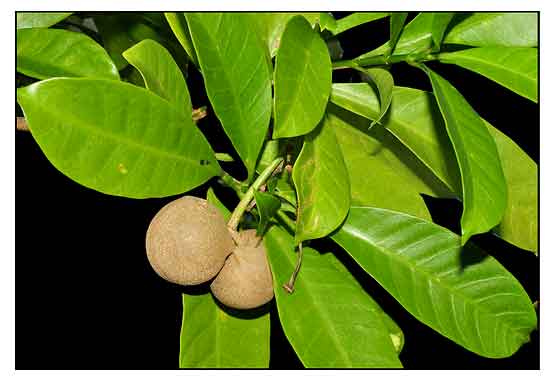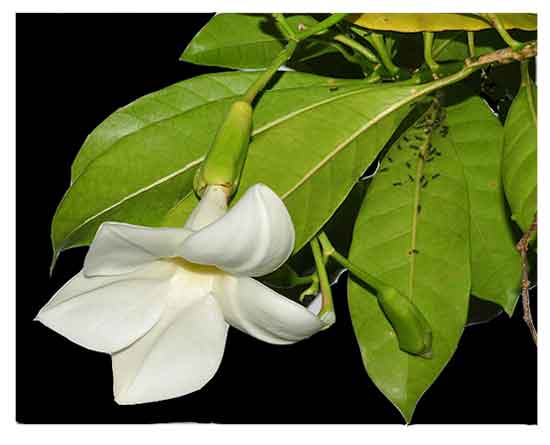 Gen info Gen info
• Voacanga is a genus of plants in the family Apocynaceae found in Africa, Southeast Asia, New Guinea, and Australia.
• As of 2013, the World Checklist of Selected Plant Families lists 13 species. Four are found in the Philippines: Voacanga foetida, V. globosa, V. grandifolia, and V. megacarpa. (2)
• Etymology: The genus was described in 1806 by Du Petit Thouars, who named it for the Madagascan words voa, meaning "fruit", and acanga, meaning "guinea fowl", referring to the spotted fruits. (3)
• The genus was described independently by Blume in 1826 as Orchipeda as O. foetida from Java. The genus and species epithets traveled a taxonomic journey until Rolfe (1883) reduced the last genus name to a synonym of Voacanga, and since then all later taxa have been described directly as species of Voacanga. (3)
-
Etymology: The specific epithet foetida derives from Latin, meaning "evil smelling".
Botany
• Shrub or tree to 20 m high; Leaves: Inflorescence few-flowered, 12−22 cm long, glabrous; Flowers with an unpleasant smell. Stamens inserted near the base of the corolla tube, at 7-10 mm from base; Ovaries glabrous, c. 2 mm high, style and style head c. 10 mm long. Fruit fleshy, free from each other, subglobose, 6−11 cm diameter. Seeds with an orange aril, furrowed, 10-12 by 5-7 by 4-6.5 mm. (Flora Malesiana)
 Distribution Distribution
- Native to the Philippines.
- Also native to Borneo, Jawa, Sumatera. (1)
Constituents
- Study isolated a new, weakly antibacterial indole alkaloid, named lombine, together with a known alkaloid voacangine. (see study below) (4)
Properties
- The 'foetida' name refers to the unpleasant smelling flowers.
-
Studies have suggested cytotoxicity, anticancer, antibacterial, antimalarial, immunomodulatory, immunosuppressive, antiproliferative, analgesic properties.
Parts used
Leaves, bark, latex.
Uses
Edibility
- Fruit is edible; eaten raw. (13)
Folkloric
- Leaves and bark used for treatment of wounds, itches, and swellings.
- In Indonesia, leaves warmed over a fire applied on chronic leg sores
. Plant latex used on skin disorders.
Others
- Wood: Use as firewood;
- Bark: Used for making rope.
Studies
• Antibacterial Alkaloid / Lombine / Bark: Study isolated a new, weakly antibacterial indole alkaloid, named lombine, together with a known alkaloid voacangine. Lombine showed bactericidal activity against Staphylococcus aureus and Escherichia coli. (4)
• Antimalarial / Antioxidant / Bark: Study evaluated the antioxidant and antimalarial activity of bark of V. foetida methanol extract and acid and base fraction. On DPPH method, the bark showed low antioxidant activity. The extract and fractions showed great activity in inhibiting Plasmodium falciparum 3D7 strain, especially the base fraction. The antimalarial activity was attributed to the alkaloid lombine. (5)
• Immunomodulatory / Alkaloid VF-1 / Stem Bark: VF-1 is an alkaloid previously isolated from a dichloromethane fraction of stem bark of V. foetida. Study evaluated the immunomodulatory activity of VF-1 compounds from stem bark. Cell viability and immunomodulatory activity were done on cultured RAW 264.7 cells (macrophages). Results showed RAW 264.7 cells treated with VF-1 at concentrations of 1, 10, and 100 g/mL appeared safe and non-toxic with cell viability values >80%. Percentage inhibition of IL-6 production at each concentration was 45.85, 58.20, and 23.25% respectively. Results suggest VF-1 has potential as an immunosuppresant in RAW 264.7 macrophage cells induced by LPS. (6)
• Cytotoxicity against T47D Breast Cancer Cells / Leaves: Study evaluated the cytotoxicity of ethyl acetate extract of V. foetida leaves using brine shrimp lethality test (BSLT) method and MTT assay against T47D breast cancer cells. The EA extract showed very toxic effect against A. salina Leach larvae with LC50 of 8.61 µg/mL and was highly cytotoxic against T47D breast cancer cells with IC50 of 0.87, o.66 and 0.95 µg/mL at 24, 48 and 72 hours of incubation time. (7)
• Anti-Proliferation Effect on Leukemia, Lung, and Cervical Cancer / Leaves: Study evaluated an the effect of butanol fraction of leaves in inhibiting proliferation of several cancer cells viz. leukemia (K562), lung cancer (A549), and cervical cancer (HeLa) using dye exclusion test. Percentage of anti-proliferation of Tb3 compound increased in a dose-dependent manner, 83% (K562), 72.3% (HeLa), and 70.7% (A549) inhibition at higher concentration, values that were relatively higher compared to positive control doxorubicin. The Tb3 IC50 values were still in the range of active cytotoxic compounds, which was less than 4 µg/mL; 0.5, 2.4, and 3.6 µg/mL for K562, A549, and HeLa respectively. Results suggest potential anticancer effect of butanol fraction of Tb3 compound through inhibition of cancer cell proliferation and an alternative for cancer therapy. (8)
• Vobtusine / Apoptosis Induction Via Caspase Pathway Activation in HL-60 Leukemia Cell Line / Bark: Vobtusine is an aspidoserpma-aspidosperma alkaloid isolated from alkaloid DCM base fraction of V. foetida bark. Sub-G1 phase population of HL-60 cells treated with vobtusine was increased compared to cells without treatment. Degree of DNA fragmentation was dependent on vobtusin concentration. After treatment with caspase-9 inhibitor, vobtusin-induced elevation of caspase-3 activity decreased, which shows caspase-3 activity depends on caspase-9. Vobtusine also induced apoptotic cell death. The vobtusine-induced apoptosis process was initiated by caspase-9 via change of Bcl-2 family protein expression, followed by cell death due to proteolytic activity. Results suggest the anticancer mechanism of vobtusin is via the intrinsic pathway. (9)
• Vobtusine / Apoptosis Induction Via Caspase Pathway Activation in HL-60 Leukemia Cell Line / Bark: Study evaluated the analgesic activity of ethanolic extract of V. foetida leaves using Writhing test on male mice induced with 0.1 ml of glacial acetic acid 1%. Results showed analgesic activity insignificantly different with positive control acetosal. Effect was different with negative control (p<0.05). (10)
• In Vivo Cytotoxicity / Acute Toxicity Test / Leaves: Study evaluated the in-vivo cytotoxic activity and acute toxicity test of ethanolic extract of V. foetida leaves against male white mice. A micronucleus assay with dose of 200 mg/kbw of leaf extract showed potential anticarcinogenic activity. The LD50 of the extract for 24 hours was observed using doses of 800, 1600, 3200, and 6400 mg/kbw. The ethanolic extract was considered non-toxic with LD50 for 24 hours > 15,000 mg/kbw. The LD50>15,000 mg. The delayed toxicity test at 800 mg/kbw did not cause significant damage to kidneys, liver, and hearts. The LD50 > 15,000 mg/kbw and long term use of high doses >1600 mg/kbw have side effects on the liver, heart, and kidneys. (11)
Availability
Wild-crafted.
|

![]()





